Reticulated Python
[Page Updated: 10 December 2023]
Reticulated Python (Python reticulatus)
Thais Say: Ngoo lam (งูหลาม)
The longest snake in the world is the reticulated python, which can reach lengths of up to 10 meters. Anacondas are the world’s heaviest serpents. They are slow moving, but they can strike with lightning speed. They are not venomous, like all pythons. They have teeth that curve backwards and grab their prey with a fork-like grip. The python wraps itself around its prey and suffocates it, rather than crushing it. The python tightens its grip on the prey each time it breathes, until the animal is unable to take another breath. Reticulated Pythons eat birds, small mammals and larger animals like deer and pigs. They may go months without eating after a big meal.
Reticulated Pythons can be found in humid environments, such as rainforests or wetlands. This python is best suited to temperatures between 24 and 35 degrees celsius with high humidity. They spend a lot of time near bodies of water, which are perfect for hiding and ambushing prey. Large snakes can also move more easily in water than on land. The smaller reticulated snakes hide in trees or sometimes cave crevices.
The reticulated Python is an oviparous snake, meaning that it lays its eggs. The reticulated snake female, unlike most snakes will remain coiled over the eggs to provide warmth. She will’shiver her body’ to generate warmth.
Reticulated Python Length
Reticulated pythons can approach 10 meters in length, though there is no hard proof that a member of the species ever reached that fantastic length. Still, stories persist. Pythons of 5-6 meters long are not very common, but they exist.
Six-seven meters was the biggest python I’ve ever seen. Typically they are in the 3-5 meter range. Once they reach 4 meters or so they start to eat farm animals and they are quickly found out. Pythons of this size are either killed, or dragged to the local snake show where they die in unclean cages or of stress.
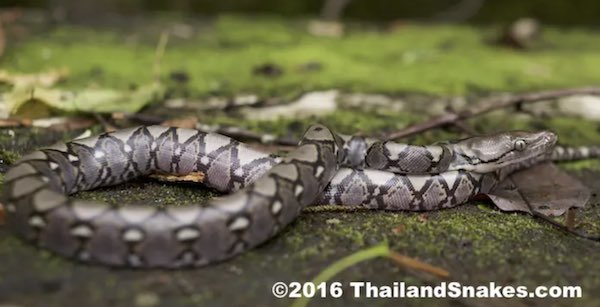
Reticulated Python Appearance
Intricate design of yellow and black lines over tan background. Head is strongly separated from neck. Can get around 1 foot in thickness.
Reticulated Python Range
All over Thailand and some other Southeast Asia countries – Burma, Malaysia in many types of habitat.
Reticulated Python Habitat
I have found them high up in trees in the mangrove above the saltwater and in the ocean near a mangrove forest. I have also found them in quite dry areas nowhere near saltwater and in residential areas as well as in floating huts on a river in the northeast.
Found often during rain, it is thought they eat frogs along streams when they cannot find a large meal. These pythons are rather common, and much more so than the other pythons.
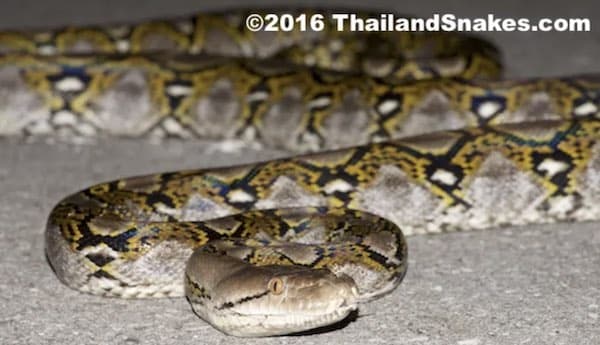
Active Time: Primarily active nocturnally, but can be found during daylight if disturbed, or sleeping at ground level.
Food: Prefer animals related to their size. Chickens of all sizes seem to be preferred, though pigs, dogs, cats, goats, frogs and other animals are taken with regularity.
Defensive Behavior: Curl into an S for a long strike. Strike is not that fast when they are big, but they have great reach! Watch out for very high strike on the upper body.
The reticulated python is quite able to defend itself and it will not hesitate to strike anything that is aggravating it. Strikes can be 2 meters in distance and they can strike quite high – head high even.
They have rows of teeth – 78 by one count, and they are very strong and curved. If you are bitten by a large python you can easily be killed as they wrap their very strong body around you and suffocate you or raise your blood pressure to such a degree that your heart can no longer beat. Your best chance is if you have a friend with you. That said, these snakes very rarely prey on man.
Venom Toxicity: Not known for dangerous venom, though all snakes are said to have venom (proteins) in their saliva. This snake kills by squeezing prey until the blood pressure is so high the heart cannot beat. Death is not due to suffocation as previously thought.
Offspring: About 50-70 cm long in large eggs. Only Blood Python eggs are known to be larger (of snakes). Hatch in June-July.
Notes: I have found a number of these pythons over the years. Many times they are swimming in water, or in trees above water – both fresh and saltwater. They have a habit of cruising up streams – where they eat large frogs and other prey. The largest I have ever seen in the wild was a 5-6 meter python in Krabi which was in a freshwater stream about midnight. A magnificent sight!
Reticulated Python Scientific Classification
Kingdom: Animalia
Phylum: Chordata
Subphylum: Vertebrata
Class: Reptilia
Order: Squamata
Suborder: Serpentes
Family: Pythonidae
Genus: Python
Species: P. reticulatus
Binomial name – Python reticulatus
(Classified by Schneider, 1801)
Small Reticulated Python Swimming in Stream
- Common Non-Venomous Snakes Post #1 Post #2
- Brahminy Blind Snake
- Brown Kukri Snake
- Copper-Headed Racer / Radiated Rat Snake | IndoChinese Rat Snake | Oriental Rat Snake / Banded | Red-Tailed Racer | Ridley’s Racer | White-Bellied Rat Snake
- Dragon Snake
- Laotian Wolf Snake
- Malayan Bridle Snake
- Orange-Bellied Snake
- Red-Tailed Pipe Snake
- Reticulated Python | Blood Python | Burmese Python
- Striped Bronzeback
- Sunbeam Snake
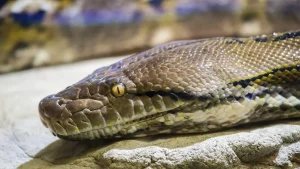

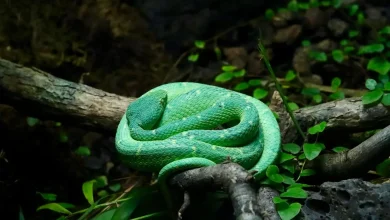
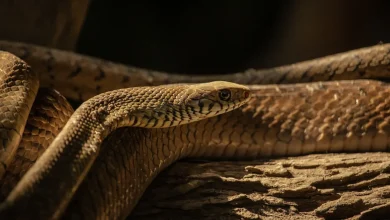
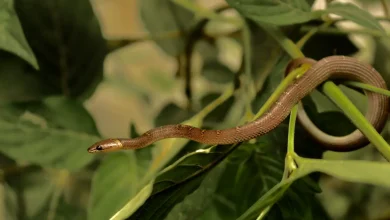
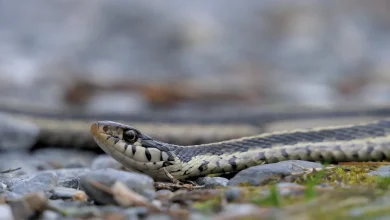
Just killed one about 120cm long in front of my place in Koh Lanta, I’m not really on the ‘killing animals’ things but was night and some people were around in a restaurant, a bar and my place so can happen that somebody crawling in it, I look at it with a flashlight and recognize it immediately he was trying to cross the road and my first thought was to pick it up from the tail, start spinning it and trow it on the other side where it was heading (I use to do like this with rat snakes and vipers in Italy) but the crowd was terrified by the idea, so I chopped its head off because it was heading for the restaurant after a couple of cars passed on the road… I don’t think he suffered. Will send you a PM on facebook for an ID if it’s not a big trouble. Your site is cool BTW :D
If you knew it was a python – why’d you kill it?
Why would you kill a completely harmless animal…
They aren’t completely harmless. There have been two cases just this year that people (adults) have been eaten by large pythons. Those were killed to recover the bodies.
Two this year, where?
One sailed over my foot in Bangkok the other night. I just stayed away but couldn’t help filming it. It was busy eating a rat so I thought it would be ok to get closer and film it. I wish I could post the video.
You can post video at the public page here on Facebook – https://www.facebook.com/groups/ThailandSnakes/
Hi Vern,
I have attached a picture of what seems to be a 2 m long reticulated python, found in a residential area in Bangkok.
I was wondering if at this size it is strong enough to wrap children or adults bodies and potentially causes death?
Would suggest if you have time that you share your knowledge on Wikipedia to educate people. As an example the page about reticulated python can lead people to think that they are one of the most dangerous snakes for humans…
Thank you.
Hi Paul,
Pythons at 2m. are certainly strong enough to kill an infant or small child. If you placed a python of that size in a room with a baby and it was hungry, it would probably try to eat the baby. It just doesn’t happen often. Most people keep a close eye on their infants.
Could it kill an adult? A very weak or feeble one, sure. Would it? No, unless somehow it wrapped around the neck or waist and the person couldn’t get it off. A small python of 2m. knows it cannot eat a human adult, so it doesn’t try.
Wikipedia is managed by people who have the time to contribute and check endlessly for changes made to the articles so they can edit out bad information. I’m not a world authority on pythons, or any snake, so I just don’t get involved with it. I wish I had the time to do a lot more with ThailandSnakes.com in English and translating it to Thai. Just no time. I’ve done pretty much all I can do. Hopefully, someone takes over the site and moves it forward another notch!
Cheers,
Vern